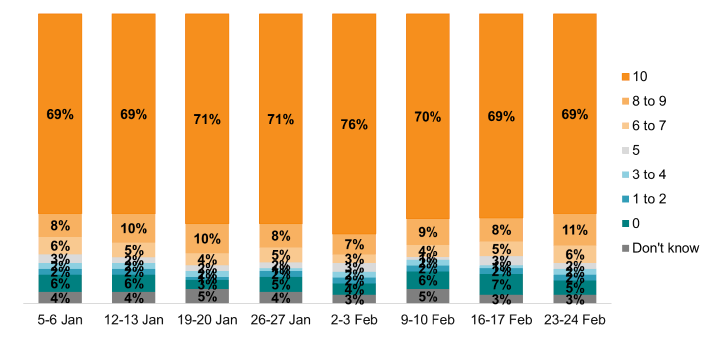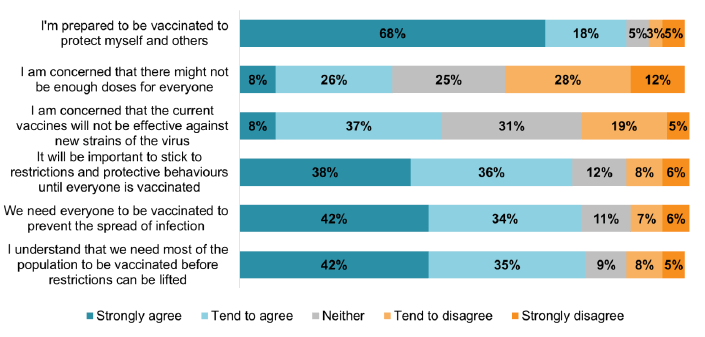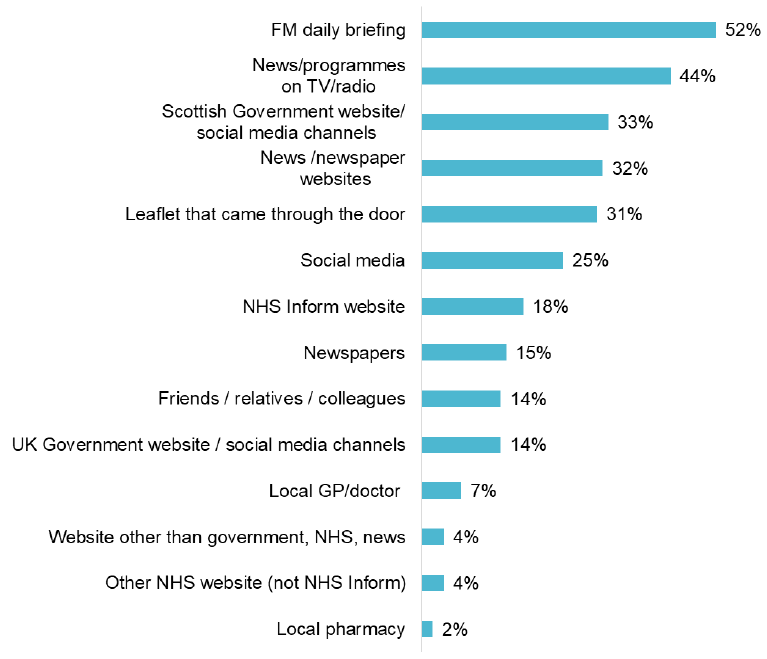Public attitudes to coronavirus: March update
This report presents findings from polling work, conducted in January and February 2021, on public attitudes to the coronavirus pandemic in Scotland.
This document is part of a collection
5. Vaccines
The Coronavirus vaccination programme began in Scotland on 8 December 2020. Since then the programme has expanded and accelerated, targeting in the first instance older age groups and priority groups.[7] This section outlines the proportion of respondents who reported receiving a vaccine during January and February 2021, and attitudes towards the vaccine.
Covid-19 vaccine
The proportion of respondents who indicated they have already received a Coronavirus vaccination increased during February, from 18% on 9-10 February to 32% on 23-24 February. Those saying they had been vaccinated reflected priority groups targeted in the vaccination programme.[8]

Source: YouGov weekly Scotland survey. Base (n=100-1016)
Using a scale of 0 ('extremely unlikely') to 10 ('extremely likely'), respondents were asked how likely or unlikely they are to be vaccinated for COVID-19 when a vaccine becomes available to them. Amongst those who had not yet received a vaccination, inclination to receive a vaccination was high and stable in January and February.[9] Around four fifths indicated they would be likely to receive a vaccination when it becomes available to them (with a score of 8-10 out of 10). Fewer than 10% indicated they would be unlikely (with a score of 0-2 out of 10).

Source: YouGov weekly Scotland survey. Base: All adults excluding those who have already received a vaccination (from left to right, n=644-1038)[10]
Respondents who rated themselves as less likely to be vaccinated (gave a score of less than 8) were provided with a list of possible reasons for not being vaccinated, and asked to choose which best described their view. As shown in Figure 33, concerns about the safety of the vaccine, and how quickly it has been developed and approved were the most common reasons for being less likely to receive the vaccine.

Source: YouGov weekly Scotland survey, 19-20 January. Base (n=125)
Respondents were also asked whether they agreed or disagreed with statements about the Covid-19 vaccine. As shown in Figure 34, the vast majority agreed that they would be prepared to receive a vaccine to protect themselves and others. Just under a half agreed they were concerned that the current vaccines will not be effective against new strains. A third were concerned there might not be enough doses for everyone. Close to three quarters of respondents agreed that it will be important to adhere to restrictions and protective behaviours until everyone is vaccinated and that they understand that we need most of the population to be vaccinated before restrictions can be lifted.

Source: YouGov weekly Scotland survey, 16-17 February. Base (n=1007)
Respondents were provided with a list of potential sources of information about the vaccine and vaccination programme. Figure 35 shows the most utilised sources were the First Minister's daily briefing and news, TV programmes and the radio.

Source: YouGov weekly Scotland survey, 16-17 February. Base (n=1038)
Contact
Email: covid-19.behaviours@gov.scot
There is a problem
Thanks for your feedback